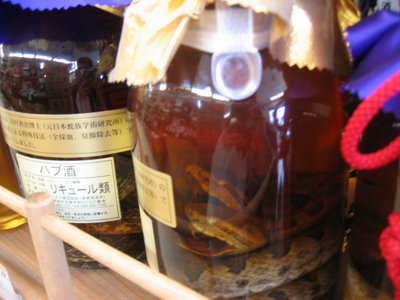Hiroshima Traces
What started as a photographic archive of my ten-month stint working in Hiroshima, traveling Asia, and living as a gaijin in Japan remains the blog of an avid traveler and aspiring sociologist.
Tuesday, May 30, 2006
Sunday, May 21, 2006
Chiiori
Chiiori is an Edo era farmhouse located in the Iya Valley of east central Shikoku. It was purchased by the travel writer Alex Kerr in the 70s, though he's apparently no longer affiliated with the project. Kerr's writing tends to be condescending and self-congratulatory expatriate ranting (a post on an Americans-in-Japan expat website put it perfectly, though I actually don't think this is a joke: "I would like to leave Alex Kerr alone so that he (and Ian Buruma) can have the peace and quiet to pen more books."), but all hard feelings aside, the house was incredible. After taking two trains and a bus through the mountains near Oboke, a small pickup truck was waiting for me on the side of the road. I hopped in the back and was ferried up the mountainside to Chiiori. The house is in fact so remote (as Kerr's book Lost Japan reiterates) that it was featured in TIME and appears in the current issue of the Atlantic Monthly. I'm not sure why I'm being such a cynic, as the place itself was truly breathtaking and the volunteer staff were incredible individuals. To be fair, I'll give Mr. Kerr the last word. From Dogs and Demons:
Occassionally one sees foreigners having an impact in certain out-of-the-way niches in Japan, such as Iya Valley in Shikoku, where the Chiiori Project, a volunteer movement centered on Mason Florence's and my old farmhouse, is drawing numerous foreign travelers and exchange teachers. The sight of all these foreigners trekking to such a remote place is reawakening local interest in reviving Iya's natural beauty.



Iya Valley:









Wednesday, May 17, 2006
Cobra Gold 2006
With so many exercises happening between so many countries at one time, everyone is bound to receive great training to take back home.
 Unfortunately, the above quote is not an excerpt from the Olympic Committee's homepage, but rather how the US Pacific Command website describes the commencement of the 25th annual Cobra Gold. What began in 1981 as joint US-Thai war games has turned into a full-blown Asian NATO, with this year's participants also including Singapore, Japan, and for the first time Indonesia. While this is Japan's second year participating, it is the first time the Self Defense Forces will actively take part in Combined Field Training Exercises. Despite an obvious violation of Article 9 of the country's Constitution, Japanese participation has been exceptionally euphemized, limiting activities to "humanitarian/civic assistance projects" (as opposed to the other countries' "peace support operations field training exercise in support of the United Nations Global Peace Operations Initiative (GPOI)").
Unfortunately, the above quote is not an excerpt from the Olympic Committee's homepage, but rather how the US Pacific Command website describes the commencement of the 25th annual Cobra Gold. What began in 1981 as joint US-Thai war games has turned into a full-blown Asian NATO, with this year's participants also including Singapore, Japan, and for the first time Indonesia. While this is Japan's second year participating, it is the first time the Self Defense Forces will actively take part in Combined Field Training Exercises. Despite an obvious violation of Article 9 of the country's Constitution, Japanese participation has been exceptionally euphemized, limiting activities to "humanitarian/civic assistance projects" (as opposed to the other countries' "peace support operations field training exercise in support of the United Nations Global Peace Operations Initiative (GPOI)").
Japanese rearmament is an explicit goal of the United States-Japan Security Consultative Committee Document Joint Statement signed on May 1 of this year by Rumsfeld, Rice, Minister of Foreign Affairs Aso Taro, and Minister of State for Defense Nukaga Fukushiro. (Rice and Taro pictured together, right.) Contained in the Statement:
The Ministers stressed the imperative of strengthening and improving the effectiveness of bilateral security and defense cooperation in such areas as ballistic missile defense, bilateral contingency planning, information sharing and intelligence cooperation, and international peace cooperation activities, as well as the importance of improving interoperability of Japan’s Self-Defense Forces and U.S. forces.
And there you have it: "interoperability" of Japan's SDF and US forces. As the new Japanese military chief of staff Massaki Hajime told Reuters:
Integrating the forces has been our dream since the Self-Defense Forces were established about 50 years ago.
Adopting the new joint staff system will also make it easier to coordinate with the United States, which has a similar structure.
Tuesday, May 16, 2006
Koizumi and the US military occupation of Okinawa
As part of the realignment package Japan and the United States finalized earlier this month, a new airfield will be built on the Nago coastline for relocation of the U.S. Marine Corps Air Station Futenma from downtown Ginowan, also in Okinawa, and Iwakuni will host a carrier air wing to be moved from Atsugi, Kanagawa Prefecture.
 "The Nago coastline" plan--blatantly euphemized in the article--will entail destruction of the Henoko reef, habitat to three species of endangered sea turtles and the rare dugong, of which only 25-50 are believed to exist (pictured right). The Henoko agreement was negotiated with the US on February 6 of last year, prompting 22 boats of protesters to take to the Bay (pictured above). The continued occupation of Okinawa and threatening of the Henoko Reef has caused nationwide outcry, resulting in the formation of groups ranging from informal networks to organized campaigns, including the Save Life Society. No Base Henoko Tokyo, and the Futenma-Henoko Action Network, as well as a massive coalition of hundreds of US environmental and legal groups. According to the Progressive Portal:
"The Nago coastline" plan--blatantly euphemized in the article--will entail destruction of the Henoko reef, habitat to three species of endangered sea turtles and the rare dugong, of which only 25-50 are believed to exist (pictured right). The Henoko agreement was negotiated with the US on February 6 of last year, prompting 22 boats of protesters to take to the Bay (pictured above). The continued occupation of Okinawa and threatening of the Henoko Reef has caused nationwide outcry, resulting in the formation of groups ranging from informal networks to organized campaigns, including the Save Life Society. No Base Henoko Tokyo, and the Futenma-Henoko Action Network, as well as a massive coalition of hundreds of US environmental and legal groups. According to the Progressive Portal:Before the drilling platforms arrived, anti-military and pro-environment activists, some as old as 90, sat in at government offices for 10 days, occupied the beachfront for more than 250 days, and held a 20-day hunger strike. When the action moved offshore, so did the opposition. The scrupulously nonviolent activists, some of whom had not previously learned to swim, became skilled rowers and divers. Former Naha City Council member Suzuyo Takazato tells of 70-year-olds in wet suits diving into the waters to disrupt the attempts to bore holes in the sea floor. At the World Social Forum in Brazil and on a subsequent visit to the U.S. this month, Ms. Takazato displayed pictures of women and elders blocking drilling workers in rowboats and occupying the drilling platforms. Rowing out to the platforms at 6:30 every morning, day after day, week after week, the resisters have managed to prevent all drilling to date. Workers have not yet been able to install a single drilling engine on any of the platforms.You can send an email to Japanese officials protesting these attacks on endangered species' habitats as well as the prolonged US military occupation of Okinawa here, thanks to a form letter created by Progressive Portal.
Relocation of Henoko residents has not been ruled out. The same Japan Times article describes how the tax-funded Japan Bank for International Cooperation will pay for the tentative relocation of a number of US military bases from Okinawa to American soil in Guam. The Asahi Shinbun reports that Japanese taxpayers will in fact foot 700 billion yen--or 59 percent--of the US military's relocation costs.
 How did Koizumi respond to the residents of Okinawa, Yamaguchi, and Kanagawa prefectures who have repeatedly expressed--in both mass demonstrations and official public referenda for over a decade--their disgust with LDP complicity in the US military occupation of Japan?
How did Koizumi respond to the residents of Okinawa, Yamaguchi, and Kanagawa prefectures who have repeatedly expressed--in both mass demonstrations and official public referenda for over a decade--their disgust with LDP complicity in the US military occupation of Japan?Prime Minister Junichiro Koizumi intends to leave it to the next session of the Diet to deliberate the bills related to Japan's cost burden. Koizumi has kept stressing that his priority is to keep his promise to Washington. Yet, he decided to let his successor explain the situation to the public.
Thursday, May 11, 2006
Okinawa

I spent Golden Week island hopping around Okinawa. The following five posts include my trips to Zamami-jima, Naha, Ishigaki-jima, Taketomi-jima, and Iriomote-jima. All photos can be enlarged by clicking on the image.

Zamami-jima
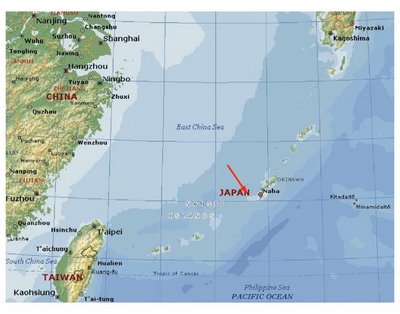
Located in the Kerama archipelago about 30 km west of Naha, Zamami-jima has but one small village with a population of about 600. Famous for its winter whale watching and summer diving opportunities, I stepped off the ferry from Naha when I spotted a whale statue and a giant "Welcome to Zamami Isl." sign.

Apparently, "Isl." was an abbreviation for "islands" plural, and I was not on Zamami Island, but instead on nearby Aka-jima in the Zamami Islands, a sub-archipelago of the Kerama Islands. I walked into the only place to stay on the island and asked where my guesthouse was located. They had no idea, which I found bizarre on an island with a population of well under a thousand. The innkeeper's daughter did know of my minshuku, tossed me in her van, and floored it back to the dock. We were just in time to see the ferry pull out...one of three ferries daily. Luckily I only had to wait another couple of hours for the next "ferry" (a three-seater, pictured below) to Zamami-jima.
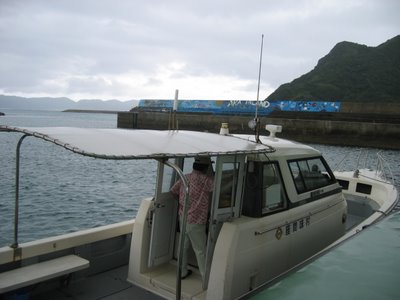
The Kerama Islands (and Zamami-jima in particular) were occupied by the US Navy navy during World War II, from which they could attack the main island of Okinawa-Honto. The great Japanese historian Ienaga Saburo describes this tragic episode:
Garrison commander Akamatsu Yoshitsugu of Tokashikijima, Kerama archipelago, Okinawa, ordered local inhabitants to turn over all food supplies to the army and commit suicide before U.S. troops landed. The obedient islanders, 329 altogether, killed each other at the Onna River with razors, hatchets, and sickles. U.S. forces occupied nearby Iejima and used some of the local people to take surrender appeals to Akamatsu's unit on Tokashikijima. Akamatsu's men klled the emissaries and many members of the island's self-defense unit for allegedly violating orders. On another Okinawan island, Zamami, unit commander Umezawa ordered the island's elderly and children to commit suicide in front of the memorial to local war dead from the Sino and Russo-Japanese Wars. The remaining islanders were forbidden to pick any potatoes or vegetables. Thirty persons who violated the order were starved or shot.
A memorial was erected by the residents of Zamami Village on Aka-jima in honor of the 200,000 who perished in the Battle of Okinawa:

My birthday dinner at a minshuku in Zamami Village:

This minshuku was built by the innkeeper's (pictured above, left) great grandparents more than 120 years ago. The structure miraculously survived the war, though some of the floorboards only barely survived the Levenson stomp:


A shiisa perched on the roof:

Furuzamami Beach:

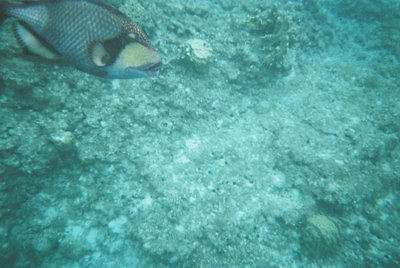
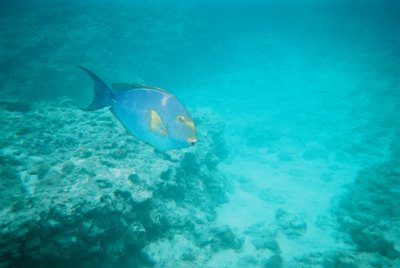




Naha

Naha is the largest city on the largest island of Okinawa, and served as the capital of the Ryukyu Kingdom. The population is just over 300,000, or about a quarter of that of the entire Okinawa archipelago. Naha is filled with Americans--American soldiers--as 20 percent of Okinawa-Honto (the island on which it is located) is occupied by US military bases. To put that into perspective, 75 percent of American bases in Japan are located on Honto, or just under 30,000 US troops. It's no wonder then that Okinawans resent this presence, a stale leftover from the US handover of Okinawa to Japan in 1972. (Okinawa was independent until Japanese annexation during the Meiji Restoration.) In 1995, Okinawans voted overwhelming in a referendum to end the occupation, and Governor Ota attempted to make good on his promise to do so. The Japanese Supreme Court overruled Ota's authority, and the largest airbase, Futenma, remains an eyesore just north of Naha (in the middle of Ginowan, population 90,000). The current proposal is to move the base northwards near the second largest city of Nago, to destroy the massive Henoko Matsuda reef, and float Futenma on a heliport in the Henoko Bay. In a blatant subversion of democracy, all subsequent (post-1995) referenda by the people of Henoko and Ginowan--again, overwhelming in favor of ending the occupation of their land by US soldiers--have been flagrantly ignored by the US and Japanese governments:
Prime Minister Koizumi told Kaga “we are now discussing things with together with the Americans. The most important thing is to be of the same mind within our government inside Japan. We must,” Koizumi emphasized, “not be of different opinions.”
A Pentagon official visiting Japan this week was more frank. “If Futenma’s transfer problem will not clear,” he said, “America is not going to think about returning a part of the base at Kadena, the southern military port, or on reducing the number of Marine Corps troops here.”
Sanshin concert in a restaurant on Kokusai-dori:


Tennyo-bashi, a bridge to the building Bezaitendo. It was built in 1502 to house a Buddhist scripture presented to the Ryukyu Kingdom by the king of Korea in the 15th century:

The remains of the late 15th century Enkakuji, once the head temple of Rinzai Buddhism in Ryukyu.

Stone gate of the Sonohyan-utaki, a shrine built in the early 16th century. The shrine itself was destroyed in the Battle of Okinawa:

Shuri-jo, the castle of the Ryukyu king, in service from the early 1400s until 1879 (the year of the Japanese annexation). It was largely destroyed in the Battle of Okinawa, though it was meticulously restored about a decade ago:



Seiden, the main palace at Shuri-jo:

Throne room:


Wednesday, May 10, 2006
Ishigaki-jima

Ishigaki-jima is the third largest Okinawan island and the most populous in the Yaeyama archipelago. About 35,000 people live in Ishigaki City, and 5000 are scattered around the rest of the largely rural island. Home to Okinawa's tallest peak, unsurpassed coral reefs (including a rare species of blue coral--ao-sango--and over a thousand others), a large manta ray habitat, and incredible beaches.

Kabira Bay:


View of the bay from my minshuku:

Kabira Shrine:

A Yaeyama firefly. Starting at sundown, the fireflies--roughly the size of gnats--start to rapidly blink for the next half hour before shutting down for the night. The forest on the mountainside was covered with blinking lights so dense that it was overwhelming.

The dead coral beach at Yonehara:


Yonehara Double Reef South:


A sea cucumber:

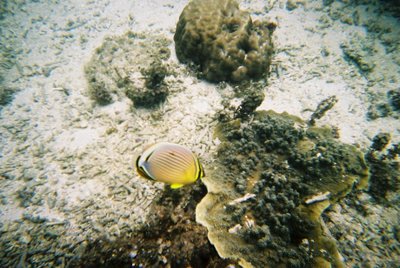




A manta ray just north of Kabira. The wingspan on this thing was about 15 feet:


A tourist brings a can of Spam home to the family. I knew the stuff was huge in Korea, but apparently it's big in Okinawa as well...to the point that I had to ask them to hold it from my goya champuru in one restaurant, and a fast food chain actually offers Spam burgers.

Okinawan pork is famous throughout the country:

A large jar of habu-shu. Habu is Japanese for pit viper, and the extremely poisonous snake is the most common in Okinawa. Shu is the same kanji used for sake and just means any type of liquor. Thus habu-shu is a massive jar of 100+ proof awamori with a giant pit viper or two shoved into the bottle.
